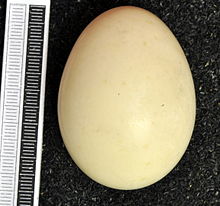| Eurasian wigeon | |
|---|---|

| |
| Male (rear) and female (front) | |
| Calls recorded in Dorset | |
| Conservation status | |
 Least Concern (IUCN 3.1) | |
| Scientific classification | |
| Domain: | Eukaryota |
| Kingdom: | Animalia |
| Phylum: | Chordata |
| Class: | Aves |
| Order: | Anseriformes |
| Family: | Anatidae |
| Genus: | Mareca |
| Species: | M. penelope |
| Binomial name | |
| Mareca penelope (Linnaeus, 1758) | |

| |
| Synonyms | |
| |
The Eurasian wigeon or European wigeon (Mareca penelope), also known as the widgeon or the wigeon, is one of three species of wigeon in the dabbling duck genus Mareca. It is common and widespread within its Palearctic range.
Taxonomy
The Eurasian wigeon was described by Carl Linnaeus in his landmark 1758 10th edition of Systema Naturae under the binomial name Anas penelope. Anas is the Latin word for "duck", and penelope refers to a duck that was supposed to have rescued Penelope when she was thrown into the sea. Her name derives from Ancient Greek πήνη pene, "braid" and ὤψ ops "appearance", from the ruse she used to deter suitors while her husband Ulysses was absent.
Description
This dabbling duck is 42–52 cm (17–20 in) long with a 71–80 cm (28–31 in) wingspan, and a weight of 500–1,073 g (1.102–2.366 lb). The breeding male has grey flanks and back, with a black rear end, a dark green speculum and a brilliant white patch on upper wings, obvious in flight or at rest. It has a pink breast, white belly, and a chestnut head with a creamy crown. In non-breeding (eclipse) plumage, the drake looks more like the female. The female is light brown, with plumage much like a female American wigeon. It can be distinguished from most other ducks, apart from American wigeon, on shape. However, that species has a paler head and white axillaries on its underwing. The female can be a rufous morph with a redder head, and a gray morph with a more gray head.
Distribution

It breeds in the northernmost areas of Europe and the Palearctic. It is the Old World counterpart of North America's American wigeon. It is strongly migratory and winters further south than its breeding range. It migrates to southern Asia and Africa. In Great Britain and Ireland, the Eurasian wigeon is common as a winter visitor, but scarce as a breeding bird in Scotland, the Lake District, the Pennines and occasionally further south, with only a handful of breeding pairs in Ireland. It can be found as an uncommon winter visitor in the United States on the mid-Atlantic and Pacific coasts. It is a rare visitor to the rest of the United States except for the Four Corners and the southern Appalachians.
Behaviour and habitat

The Eurasian wigeon is a bird of open wetlands, such as wet grassland or marshes with some taller vegetation, and usually feeds by dabbling for plant food or grazing, which it does very readily. It nests on the ground, near water and under cover. It is highly gregarious outside of the breeding season and will form large flocks. They will join with flocks of the American wigeon in the United States, and they also hybridize with them. This is a noisy species. The male has a clear whistle that sounds like: "pjiew pjiew", whereas the female has a low growl: "rawr".
The Eurasian wigeon is one of the species to which the Agreement on the Conservation of African-Eurasian Migratory Waterbirds (AEWA) applies. Its conservation status is least concern.
Footnotes
- ^ BirdLife International (2017). "Mareca penelope". IUCN Red List of Threatened Species. 2017: e.T22680157A111892532. doi:10.2305/IUCN.UK.2017-1.RLTS.T22680157A111892532.en. Retrieved 13 November 2021.
- Linnaeus 1758
- Mayr, E.; Cottrell, G.W., eds. (1979). Check-list of Birds of the World, Volume. Vol. 1 (1 2nd ed.). Cambridge, Massachusetts: Museum of Comparative Zoology. p. 462.
- Jobling, James A (2010). The Helm Dictionary of Scientific Bird Names. London: Christopher Helm. pp. 46, 296. ISBN 978-1-4081-2501-4.
- ^ Floyd 2008
- Dunning 1992
- ^ Dunn & Alderfer 2006
- ^ Clements 2007
References
- Clements, James (2007). The Clements Checklist of the Birds of the World. Ithaca: Cornell University Press.
- Dunn, J.; Alderfer, J. (2006). National Geographic Field Guide to the Birds of North America (5th ed.).
- Dunning, John B. Jr., ed. (1992). CRC Handbook of Avian Body Masses. CRC Press. ISBN 978-0-8493-4258-5.
- Floyd, T. (2008). Smithsonian Field Guide to the Birds of North America. NY: Harper Collins.
- Linnaeus, C. (1758). Systema naturae per regna tria naturae, secundum classes, ordines, genera, species, cum characteribus, differentiis, synonymis, locis. Tomus I. Editio decima, reformata. Vol. 1. Holmiae : (Laurentii Salvii). p. 126.
A. cauda acutiufcula subtus nigra, carite brunneo, fronte alba.
(in Latin)
Identification
- Cox, Cameron; Barry, Jessie. "Aging of American and Eurasian Wigeons in female-type plumages" (PDF). Birding. 37 (2): 156–164. Archived from the original (PDF) on 2012-10-19. Retrieved 2011-10-09.
Gallery
-
 Eurasian wigeon pair at Nandur Madhmeshwar Bird Sanctuary, India
Eurasian wigeon pair at Nandur Madhmeshwar Bird Sanctuary, India
External links
- Wigeon at RSPB's Birds by Name
- "Eurasian wigeon media". Internet Bird Collection.
- Eurasian wigeon photo gallery at VIREO (Drexel University)
- Feathers of Eurasian wigeon (Anas penelope) Archived 2018-03-04 at the Wayback Machine
- Interactive range map of Mareca penelope at IUCN Red List maps
- BirdLife species factsheet for Mareca penelope
- Audio recordings of Eurasian wigeon on Xeno-canto.